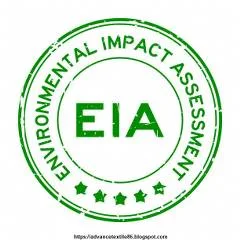Environmental Impact Assessment
Environmental Assessment (EA) is the assessment of the environmental consequences of a plan,
policy, program, or actual project before deciding to proceed with the proposed
action. In this context, the term Environmental Impact Assessment is usually
applied by an individual or company to an actual project, and the term
Strategic Environmental Assessment is often applied to proposed policies,
plans, and programs as part of the state. It is a tool for environmental
approval that is part of project approval and decision-making. Environmental assessment
may be regulated by rules of administrative procedure relating to public
participation and decision-making documents and may be subject to judicial
review.
The purpose of the assessment is to ensure that decision-makers consider environmental impacts when deciding which project to proceed with. The International Association for Impact Assessment (IAIA) defines an environmental impact assessment as a process of identifying, predicting, evaluating, and mitigating the biophysical, social, and other relevant effects of development proposals before making major decisions and commitments. EIAs are unique in that they do not require adherence to their predetermined environmental outcomes, but rather they require decision-makers to calculate environmental values in their decisions and justify those decisions in light of detailed environmental studies and public comments on potential environmental impacts.
Environmental impact assessment objectives
The
objectives of the Environmental impact assessment is to-
i. To protect the elements of the environment
within the legislative authority of Parliament from the significant adverse
environmental effects caused by a scheduled project;
ii.
To ensure that scheduled projects are considered in a careful and cautious
manner to avoid significant adverse environments in order to ensure that the
power or performance of federal authority is required under any law of
Parliament other than this Act;
iii.
Promote cooperation and coordinated action between the federal and provincial
governments on environmental assessment;
iv.
Promoting communication and cooperation with indigenous peoples in
environmental assessment;
v.
Ensuring opportunities for meaningful public participation during environmental
assessments;
vi.
To ensure timely environmental assessment is completed;
vii.
Projects defined in Section 66, which will be undertaken on federal land, or
which are outside of Canada and which will be managed or financially supported
by federal authorities, are carefully and cautiously considered to avoid
significant adverse environmental impacts;
viii.
Encourage federal authorities to take steps that encourage sustainable
development to achieve or maintain a healthy environment and a healthy economy;
and
ix.
Encouraging the study of the growing effects of physical activity in a region
and the consideration of that study leads to environmental assessment.
Environmental impact assessment methodology
The
main methodologies adopted to complete the EIA are as follows:
i.
The study of the relevant documents related to policy, legal and administrative
structures, and their review, especially environmental aspects and limits of
waste disposal, health and safety requirements, identification of sensitive
areas and endangered species, land use, etc.
ii.
A renewal survey was conducted to collect baseline data in the planned format;
iii.
The collected data were analyzed;
iv.
Baseline conditions were documented by environmental monitoring of the site;
v.
Identification of major project activities during both the construction and
management phases of the project.
vi
Identify and forecast the environmental impact of project activities on the
surrounding environment
vii.
Identify the most important environmental and social impact and mitigation tips
to reduce/eliminate negative effects and maximize positive effects.
viii
Organizing public consultation meetings to consult with potential victims as
well as people in the community;
ix.
Development of an Environmental Management Plan (EMP) for both project
construction and management phase;
Environmental impact assessment methods
i.
Ad hoc method
ii.
Checklist method
iii.
Matrix method
iv.
Network method
v.
Overlay method
vi.
Environmental index using factor analysis
vii.
Cost/Benefit analysis
viii.
Predictive or Simulation methods
Ad hoc method
Ad
hoc methods indicate a wide range of potential effects by listing compound
environmental parameters that may be affected by the proposed activity. These
methods involve assembling a team of experts who identify the impact on their
skills. Here, each parameter is considered separately and the nature of the
effect is considered.
These
methods give a rough assessment of the total effect while giving a wide area
and the general nature of the potential effects. In this method, the evaluator
relies on an intuitive approach and performs a broad-based qualitative
assessment. This method serves as a preliminary assessment and helps to
identify important areas such as-
a.
Wildlife
b.
Endangered species
c.
Natural vegetation
d.
Exotic vegetation
e.
Grazing
f.
Social characteristics
g.
Natural drainage
h.
Groundwater
i.
Noise
j.
Air quality
k.
Visual description and services
l.
Open space
m.
Recreation
n.
Health and safety
o.
Economic values and
p.
Public facilities
This method is very simple and can be done without any training. It does not involve
any relative weight or any cause-and-effect relationship. It provides minimal
guidelines for impact analysis while advising a broad field for potential
impacts. Moreover, it does not even say the actual effects on the specific
parameters that will be affected.
Checklist method
In this method, environmental factors are listed in a structured format by
applying weights of importance to the factors and scaling techniques for the
impact of each option. The checklist is a strong indicator of impact
identification. They effectively gain the attention and awareness of their
audience. Impact detection is a fundamental function of an EIA. The checklist
may be:
A.
Simple
B.
Descriptive
C.
Scaling or
D.
Weight type
In
the checklist method, the effects are tabulated in the form described with
cell-shaped information that gives information about the probability or the possible existence of the effect where the scaling or weighting method gives
the level of importance of the effect.
Matrix method
This method provides a framework for the interaction of the various activities of a
project with the potential environmental effects caused by them. A general
interaction matrix is formed when project actions are listed on one axis
(usually vertical) and environmental effects are listed on another axis. This
strategy was introduced in 1971 by Leopold et al. It has about 100 project
works and about 88 environmental features and conditions.
Network method
This method uses the matrix method and extends it to include both primary and
secondary effects. It is shown in the form of a tree whose name is an impact
tree. This diagram is also called a reference or sequence diagram. Direct,
indirect identification along with short, long term effects is an important and
fundamental step in creating an impact tree. The impact tree is used to
identify cause-effect connections. A visual description of the impact tree
links.
Overlay
This approach relies on a map of the environmental characteristics of a project area
that includes physical, social, environmental, and aesthetic aspects. It
enables individual mapping of critical environmental features to the same
extent as to project site plans (e.g. wetlands, steep slopes, soils,
floodplains, bedrock outcrops, wildlife habitats, plant communities, cultural
resources, etc.). In the old technique, the environmental characteristics were
mapped on transparent plastic in different colors. Modern techniques of the
same operation are accomplished using computer software, hardware, data, and
skilled people. This is called Geographic Information System (GIS).
Environmental impact assessment benefits
i.
Reduced cost and time of project implementation.
ii.
Cost-saving modifications in project design.
iii.
Increased project acceptance.
iv.
Avoided impacts and violations of laws and regulations.
v.
Improved project performance.
vi.
Avoided treatment/clean-up costs.
vi.
A healthier local environment (forests, water sources, agricultural potential,
recreational potential, aesthetic values, and clean living in urban areas).
vii.
Improved human health.
viii.
Maintenance of biodiversity.
ix.
Decreased resource use.
x.
Fewer conflicts over natural resource use.
xi.
Increased community skills, knowledge, and pride.
Limitation of EIA
The
potential effects involved in this EIA construction and operation phase are
limited to investigation and management. This EIA should in no way be construed
as providing an impact assessment for work or development on this or any other
site. This project has not resulted in any evaluation for any future projects
or activities. If or when such a development is proposed, additional
environmental impact assessments should be made at that stage in accordance
with the legal requirements of Bangladesh.
This
EIA study is limited to the study of the potential effects of the project on
the physical, biological, and socio-economic environment of the area. This study
was conducted by accessing data from a wide range of primary and secondary
data. This includes literary reviews, reports, and other documents, which have
been supplemented with the collection of primary field data. Project evaluation
is limited by the amount and quality of data available.
Some
provisions of this EIA report assume reliance on conceptual design and
technical information. If the design of the evaluated project changes due to
design development, the inclusion of new information, a change in motivation,
or any other reason, the results of any impact assessment or mitigation
measures provided in this report may be inconsistent.










0 Comments